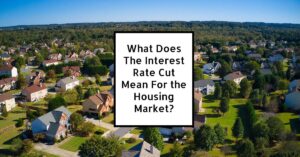It’s an exciting time for the housing market next year! An influx of young people is set to make waves as they eagerly step into homeownership. With mortgage rates gradually trending lower, this could be the perfect storm to spark a homebuilding boom.
According to Business Insider, industry expert Phillip Ng, a senior analyst at Jefferies, believes the construction and building materials sector could experience a significant boost. The anticipation of a fresh wave of young homebuyers is not just optimistic thinking; it's grounded in economic trends, and it’s definitely worth discussing.
Young Buyers Set to Transform the Housing Market in 2025
Key Takeaways
- Mortgage Rates: Expected to lower, easing the cost of borrowing.
- Young Buyers: A wave of millennials and Gen Z are looking to buy homes.
- Construction Boom: Increased demand will lead to a surge in homebuilding.
- Underbuilt Market: Current housing supply has not kept up with demand.
- Forecasts: New home sales are predicted to rise by 14% in 2024.
Over the last few years, the housing market has been a tricky maze for buyers, especially young ones who are just starting to explore their options. High prices and elevated mortgage rates have restrained potential buyers. Many established homeowners are reluctant to sell their properties, clinging to the lower interest rates they locked in during the past years. This phenomenon is known as the “lock-in” effect. Despite this, the horizon looks brighter, as analysts predict that young Americans are poised to enter the housing market in larger numbers next year.
Phillip Ng, from Jefferies, remains optimistic about the upcoming shift in the housing landscape. In a recent interview with CNBC, he revealed his excitement about 2025, stating, “The housing market's been massively underbuilt. We've got a wave of young people that are going to be buying homes.” With predictions of continued declines in mortgage rates, the affordability crisis might finally ease, leading to an uptick in construction activity.
In the current housing market, existing homeowners often enjoy lower mortgage rates, allowing them to stay put rather than sell. Data from Redfin shows that about 89% of existing homeowners have a mortgage rate below 6%. This creates a challenging atmosphere for new homebuyers because fewer listings mean stiff competition for available properties. However, with expectations that mortgage rates may drop further, the stage is set for a more vibrant buying environment.
The Role of Mortgage Rates in the Housing Market Next Year
The 30-year fixed mortgage rate currently fluctuates around 6.35%, nearing its lowest level since early 2023, according to Freddie Mac. If mortgage rates can drop further, buyers may feel less hesitant to enter the market. Forecasters predict that a combination of factors, including rising affordability and increased demand from younger buyers, will lead to a significant lift in housing activity.
The National Association of Realtors projects that new home sales might increase by a remarkable 14% in 2024. With a growing number of younger buyers ready to make their mark, builders are optimistic about ramping up construction. In fact, the market is already witnessing a trend where new homes account for one out of every three properties for sale.
Despite the recent challenges, the homebuilding industry appears to be on a roll. Builders have raced to increase inventory due to a prolonged supply shortage. In July, there were approximately 7.5 months worth of new housing supply available, which is a promising sign for both builders and buyers alike. Strong demand, coupled with stable pricing for building materials, is driving this surge in new home construction.
Demand Dynamics Shape the Future of Homebuilding
The interaction between young people's ambitions and housing supply creates a fascinating dynamic. As more millennials and members of Gen Z prepare to make their homeownership dreams a reality, it creates a strong demand for residential properties. This demand is welcomed by builders who are eager to meet it. As Ng highlighted, while the construction and building materials markets have faced ups and downs, the overall tone for new projects is positive.
Builders have been positively influenced by rising home prices, which have been booming in many regions. The increasing costs of homes reflect heightened buyer interest, particularly from the younger demographics looking for their first home. Lower rates not only improve affordability for buyers, but they also give builders the necessary confidence to invest in new projects. As home prices remain high, builders are also keeping a close watch on building material costs. While the price of lumber has seen a decline over the past year, other costs have remained stable, allowing builders to maintain profitability.
However, it’s important to acknowledge that some uncertainties remain. Housing experts caution that while mortgage rates may decrease, they could still hover above the 6% threshold by the end of 2024. This lingering uncertainty might affect the speed with which young buyers enter the market. Still, the downward trend of mortgage rates and the excitement of new buyers present a favorable scenario for the construction sector.
Sector Impacts and Opportunities Ahead
The potential homebuilding boom anticipated next year does not only signify benefits for builders and new homeowners but also points to wider economic growth. An increase in construction activity leads to job creation, stimulates local economies, and can significantly aid in alleviating the existing housing supply crisis.
For many young buyers aspiring to enter the housing market next year, homeownership represents a significant life milestone. It is their chance to invest in a stable future, create a sense of belonging, and build wealth. The upcoming wave of purchases could shift the market dynamics, allowing new generations to finally break into homeownership after years of delays due to affordability constraints.
As the housing market prepares for this influx of youthful buyers, the ripple effect of this increased activity is likely to touch various facets of the economy. From real estate agents to furniture stores, many sectors will benefit and see increased interactions with young homeowners who are ready to fill their new spaces.
In conclusion, as we gaze into the future of the housing market next year, it’s clear that optimism abounds. With an influx of young people looking to buy homes and favorable conditions around mortgage rates and building materials, we could soon witness a revitalization in the housing sector. The anticipation that accompanies these predictions suggests that the coming years might not only fulfill the dreams of new homeowners but also pave the way for a more robust, resilient housing market.
FAQs
1. What is a buyer's housing market?
A buyer's housing market occurs when there is an increase in the number of homes for sale compared to buyers looking to purchase. This often leads to reduced competition among buyers, giving them more negotiating power regarding prices and terms.
2. Why are mortgage rates dropping?
Mortgage rates can drop due to various economic factors, including changes in the Federal Reserve's interest rate policies, overall economic conditions, and inflation rates. Recently, the Fed cut rates, which often leads to lower mortgage rates for homebuyers, making borrowing less expensive.
3. How does the influx of young buyers affect the housing market?
The entry of millennials and Gen Z into the housing market is anticipated to increase demand for homes. This surge may result in a more competitive environment, but it can also motivate builders to increase new construction to meet the demand.
4. What are the current trends in home prices?
While the median price of homes has seen a slight dip, the price per square foot has increased, indicating that buyers may be getting less value for every dollar spent. This trend shows that high demand continues to keep some upward pressure on prices, particularly in sought-after areas.
5. How can homeowners benefit from the current market conditions?
Homeowners looking to sell may benefit from a larger number of potential buyers who are eager to purchase, especially if they have properties in high-demand areas. They could price their homes competitively to attract buyers looking for the best deals.
Also Read:
- A Buyer’s Housing Market Might Be Around the Corner
- Why Falling Mortgage Rates Won't Make Much Impact for Buyers
- First-Time Home Buyer Government Programs: Guide for Buyers
- 5 Mistakes First-Time Homebuyers Make (and How to Avoid Them)
- Why Are Houses So Expensive in 2024: Trends and Economic Influences
- Housing Market Predictions for the Next 4 Years: 2024 to 2028
- Real Estate Forecast Next 5 Years: Top 5 Predictions for Future











